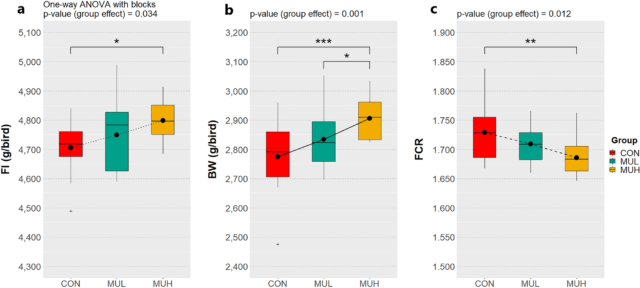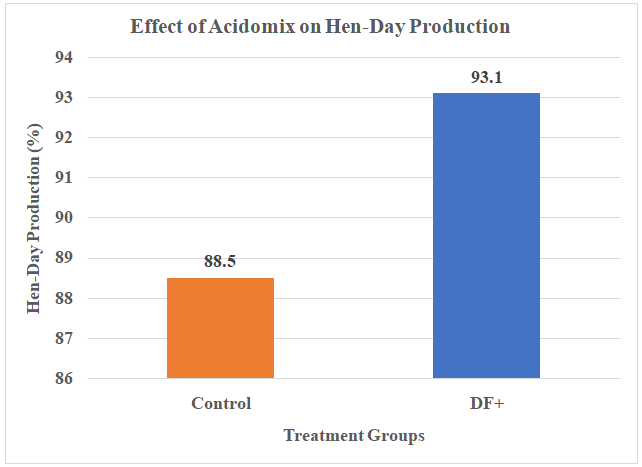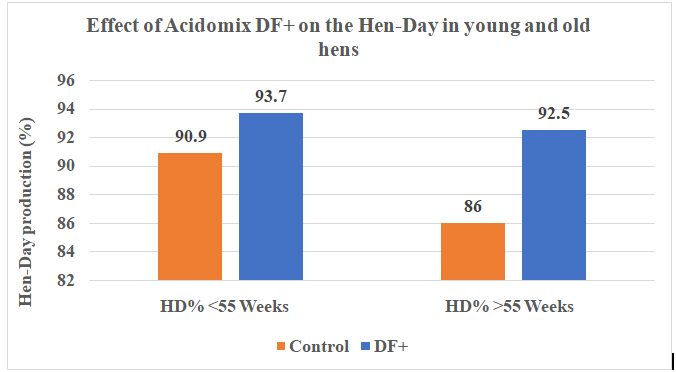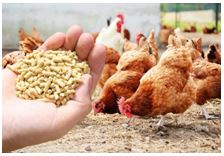
Christian Lückstädt, Addcon Asia Ltd, India.
Organic acids have long been used in animal nutrition, usually to stabilize compound feed, but also to enhance animal performance. In poultry one of the first reports of improved broiler performance when diets were supplemented with single acids was for formic acid (Vogt et al., 1981).Later, similar effects were noticed for fumaric acid (Patten et al, 1988; Kirchgessner et al., 1991; Skinner et al., 1991). Izat et al. (1990a) found significantly reduced levels of Salmonella spp. in carcass and caecal samples after including calcium format in broiler diets. In another trial from Izat et al. (1990b), buffered propioguardiani scarpe jordan max aura 4 nike air max 270 sale air max 95 sale saldi marella uberlube luxury lubricant custom maple leafs jersey jordan air force 1 nike ispa 270 castelli vantaggio jersey castelli tutto nano jersey best jordans harmont & blaine outlet shop online corinne abbigliamento sexy custom nfl football jerseysnic acid was used to counteract pathogenic microflora in the intestine and carcass of broiler chickens, and resulted in a significant reduction in E. coli and Salmonella spp. The use of pure formic acid in breeder feed reduced the contamination of tray liners and hatchery waste with S. enteritidis drastically (Humphrey et al., 1988). Kirchgessner et al. (1992) found significantly better feed utilization in laying hens after adding fumaric acid, but only when the feed was low in protein and methionine and cysteine. Performance enhancement was influenced by both quantity and quality of the protein. Although growth performance benefits of organic acids and their salts have been shown in numerous studies over the past half-century, the significant increase in scientific and commercial focus shifted on it only after ban on antimicrobial growth promoters in Europe.
An important limitation, however, is that organic acids are rapidly metabolised in the foregut (crop to gizzard) of birds, which will reduce their impact on growth performance. A new molecule (sodium diformate, similar to potassium diformate) has been proven to be effective against pathogenic bacteria, including salmonella, along the whole gastro-intestinal tract (Lückstädt et al., 2009). The reduced impact of pathogenic bacteria on the broiler, as well as the improved gut microflora, leading to a state of eubiosis in treated chickens, suggests that including sodium diformate in broiler diets will also result in improved bird performance. Several trials have also been carried out over the last half-decade world-wide that document positive effects on broiler performance.
It was therefore interesting to estimate the potential impact of sodium diformate (Acidomix DF+) in poultry production and Salmonella control through an analysis of the results of such trials.
Effect of Acidomix DF+ on Broiler Performance
This study analyzed the average impact from all studies on the effect of the additive on the performance parameters weight gain, feed efficiency, mortality, and productivity, as measured using the European Broiler Index, (EBI). EBI is calculated using the following equation:
EBI = ADG [g] × survival [%] / (10 × FCR)
The final dataset contained the results of 8 documented, negatively controlled studies, comprising 17 trials with DF+-inclusion, which ranged from 0.1% to 0.6%. Those studies were carried out between 2006 and 2012 across the world under both commercial and institutional conditions and included more than 36,700 broilers from different breeds (Arbor Acres, Cobb, Hubbard) raised to between 35 and 44 days. The above-mentioned performance parameters are expressed as percentage difference from the negative control. The results are given as mean and were statistically analysed using the t-test. A confidence level of 95% was defined for these analyses.
The average level of dietary DF+ from the dataset in all treated broilers was 0.28%. Typical dosage for DF+ in broilers ranges from 1-2 kg/tone feed, depending on age (dietary protein level) and hygienic status of the farm. As shown in Table 1, DF+ inclusion resulted in a numerical increase in feed intake of 1.1% (P=0.22).
Table 1. Performance analysis of 17 trials with broilers, fed diets with Acidomix DF+, expressed as an average percentage difference from negative control.
| Dosage | Feed intake | Weight gain | FCR | Survival | EBI |
| 0.28 | +1.1 | +5.2 | -4.1 | +2.3 | +12.4 |
| P-value | 0.22 | 0.0001 | 0.002 | 0.034 | 0.0005 |
The performance of broilers based on daily gain was significantly increased by 5.2% (P<0.001). Furthermore, the FCR was also significantly improved (4.1%; P<0.01). Survival was increased on average by 2.3% (P<0.05). Finally, the EBI improved significantly due to the inclusion of NDF by 12.4% (P<0.001). In broilers, improved zootechnical performance is thought to stem from both improvements in the intestinal microflora, as a result of suppressing pathogenic bacterial species, and improved protein digestion. As often seen with other additives, hygiene challenge also plays some role in the performance observed. In the present performance analysis, a range of hygiene conditions were included, representing both university and farm trials. The average impact of DF+ inclusion on performance remained above that normally expected. It can therefore be concluded that dietary sodium diformate (Acidomix DF+) can play an important role in improving broiler production world-wide, especially in times of high raw material prices.
Effect of Acidomix DF+ on Salmonella Control
Salmonella ranks among the world’s biggest threats to health. Annually, it has been estimated that cases of human salmonellosis in the United States may actually vary from 2 to 4 million (Jones, 2011). Developing and implementing effective Salmonella monitoring, reporting and control systems is prioritised in many countries. Salmonella is often associated with poultry products, mainly chicken and eggs. Salmonella is widely distributed in nature (Winfield and Groisman, 2003) and can survive for an extended period of time on diverse materials (Humphrey, 2004). Since its discovery in the late 19th Century, more than 2,500 different serovars have been discovered. These have emerged over the past 30 years, in parallel with the development of intensive systems of animal husbandry. In the European Union, the proportion of Salmonella and E. coli isolates resistant to ampicillin, sulfonamides and tetracycline were found to vary between 5 and 68 % in poultry, pigs and cattle. Some Member States reported a high occurrence of fluoroquinolone resistance in Salmonella isolates from poultry (5-38%), (EFSA, 2010).
The risks posed by contamination with pathogenic bacteria in the food chain can be reduced without the prophylactic use of antibiotics. Applying appropriate control measures at intervention points in the food chain can help reduce the risk of Salmonella proliferation. While Salmonella cannot be fully eradicated in poultry units, it can be controlled to minimise the risk to consumers. According to Jones (2011) Salmonella control measures in feed can be divided into three major categories: prevent contamination of the facility; measures to reduce multiplication of the bacteria in the plant; and procedures to kill the pathogen. Biosecurity plays a significant role in Salmonella control. In feed compounding, although heat treatment is effective in reducing contamination of feed leaving the feed mill, this effect does not persist during transport, storage and subsequent out-feeding. When conditions within the feed are less conducive to bacterial infection, Salmonella contamination can be reduced. The next critical control point is within the bird, where conditions for bacterial growth are optimal. Salmonella growth is optimal between 35 and 37°C, with moisture content greater than 12% and a pH of 4.5-9.0. Jones (2011) suggests addition of chemical agents to the feed to control Salmonella. This may primarily involve the use of organic acids.
Since the 1980’s, reports have shown organic acids, and formic acid in particular, to be especially effective against Salmonella, when used in poultry diets. The use of pure formic acid in breeder diets reduced the contamination of tray liners and hatchery waste with S. enteritidis drastically (Humphrey and Lanning, 1988). By 1990, researchers in the US found significantly reduced levels of Salmonella spp. in carcass and caecal samples, after including calcium formate in broiler diets (Izatet al., 1990). Further research (Kovarik and Lojda, 2000) reported that inclusion of formic acid at 0.5% in the diet can be successfully used on farms to reduce salmonella contamination in the feed, excretion of Salmonella spp. and re-infection of chicken populations.
A number of practical considerations also need to be addressed. Pure formic acid, although it is very effective in controlling Salmonella in feed, is corrosive, hazardous, and volatile, so is difficult to handle easily and safely in the feed mill. Furthermore, pelleting may incur losses of around 15% of the acid. Often, liquid and volatile acids exert their antibacterial effects only in the feed and the birds’ foregut. More recently, research has focused on overcoming these limitations to develop chemical compounds which are heat-stable, non-corrosive and yet still effective. Sodium diformate (Acidomix DF+, hereafter abbreviated as DF+) satisfies such industry requirements. An organic acid salt, it is crystalline and non-volatile, meaning that it can be used safely in the feed mill, as well as being effective in the animal.
A UK-study evaluated the anti-Salmonella effects of DF+ in vitro, against Salmonella enteritidis (SE)S9549/07 found in broiler flocks (Wales et al., 2013). Caecal and crop samples were taken from slaughtered broilers from small-scale commercial operations. Caecal contents were used fresh; crop contents were stored at -80°C and thawed before use. Both were mixed with quarter strength Ringer’s solution (crop at a 1:1 ratio; caecal contents at 1:2). DF+ was added to 20g aliquots in tubes. These were incubated in a water bath for 10 minutes at 41.5°C, after which time a 0.1ml stationary phase SE culture was added. All preparations were vortex mixed and incubated at 41.5°C. After various time intervals (1, 4 or 8 hours for crop contents; 1, 4, 9 and 24 hours for caecal contents), 5g aliquots were taken, mixed with buffered peptone water (BPW) and prepared for Salmonella enumeration. SE counts were recorded as a log reduction, compared to the negative control.
The objective of the second study was to evaluate the effect of DF+ in broilers in vivo, on the control of bacterial contamination in the digestive tract in comparison to a negative control in-vivo (Lückstädt and Theobald, 2009). 1125 broilers were distributed in 9 batches of 125 birds each (5 batches in the treatment; control with 4 batches only). The broilers were fed the following program: starter diet for 21 days, grower diet for 18 days and finisher diet for 3 days only. Birds were treated with 0.3% DF+. After 39 days of treatment, before the finisher feed was given, 10 birds from each of the 3 treatments were taken for further microbial analysis and were screened for Salmonella. The collected data were analysed with ANOVA by the Statistics XL program. A P<0.05 value was considered to be a significant result.
In vitro study
Table 1 shows the log reduction in SE counts after application of sodium diformate at the manufacturer’s maximum recommended dose (0.6%) to samples of crop or caecal contents; this dosage was used for the laboratory test. In practice lower dosages are used. There, and especially in broiler production the recommended dosage for an anti-Salmonella effect lies at 1-2 kg/t.
Table 2. Reduction in Salmonella enteritidis (log10) over time in crop or caecal content treated with 0.6% DF+ (after Wales et al., 2013).
| 1 h | 4 h | 8 h | 9 h | 24 h | |
| Crop contents | 3 | >6 | >6 | n.d.* | n.d.* |
| Caecum contents | 1 | 1 | n.d.* | 2 | 4 |
*not determined
In the crop, exposure of inoculated crop contents to DF+ resulted in a log 3 reduction in SE counts after 1 hour, reducing further to >log 6 at both 4 and 8 hours. Anti-Salmonella activity in the crop, by rapidly reducing the crop pH and killing Salmonella, may be particularly suited to combating the ingested pathogen from various contamination vectors (feed, environment, litter, etc.).
In caecal contents, only log 1 reduction in SE count was observed after 1 hour incubation, reducing further to log 2 reduction after 9 hours, compared to the negative control. This effect was further pronounced after 24 hours’ incubation, with a reduction in SE count of log 4. Since the retention time in the hindgut of chickens is significantly longer, compared to the ‘foregut’ (crop, gizzard, proventriculus), the reduction in SE count after 24 hours may allow for a continuation of protection against the pathogen. The strong results with a reduction of up to 6 logs (see table above) suggest that also a lower dosage will show significant results, since it has to be mentioned that a reduction by log 2 means already 99% lower Salmonella levels. This approach was used in the in vivo study below.
In vivo study
Results of the in vivo study are shown in Table 3 (Lückstädt and Theobald, 2009). No positive samples were found for Salmonella in the crop (P=0.15) or intestine (P=0.15) at 0.2% (the recommended commercial dose in case of a suspected pathogenic challenge).
Table 3. Results of sodium diformate (DF+) on Salmonella inhibition (% positive samples) in broiler chickens (after Lückstädt and Theobald, 2009).
| Organs | Control | DF+ 0.3% |
| Crop (microbiol.) | 20 | 0 |
| Intestine (microbiol.) | 20 | 0 |
| Faeces (microbiol.) | 25 | 0 |
| Meat (serol.) | 0 | 0 |
Further studies on the anti-Salmonella effect of DF+ were carried out in the Ukraine at the Animal Agriculture Institute of National Academy of Agricultural Sciences of Ukraine (2012). In that trial Cobb 500 birds were challenged with feed which contained 109 CFU/ml Salmonella Typhimurium (strain no. 371). The trial lasted for a period of 6 weeks. Organs of birds (heart, lung and spleen) as well as intestine and manure were tested for Salmonella in birds fed with (0.3%) or without DF+. After the trial the negative control had positive samples of Salmonella in all organs, the intestine, and the manure – whereas in the DF+ treated group the Salmonella was below the detection level.
The above stated trials are in-line with experience from users of DF+ in Europe and Asia. The product is used for its anti-bacterial action, against Salmonella or E.coli, for instance in Germany, UK and Spain – or if talking about Asia, e.g. in India or the Philippines. Here, customers use the recommended dosage for the anti-Salmonella effect of 3 kg/t as long as the thread of the bacteria is present. After that, the normal broiler dosage of 1-2 kg/t of finished feed is recommended.
However, it has to be stated that the currently reduced threat with Salmonella in Europe – latest figures from the EU zoonosis report (EFSA, 2021) report only 60.000 cases of Salmonellosis in humans (which is a reduction from more than 131.000 cases in 2008 – EFSA zoonosis report 2010) cannot be alone accounted for the use of acidifiers like DF+, but has to be seen as a combination of increased biosecurity and improved management in general, which includes however the use of additives with anti-Salmonella action.
Acidomix DF+ Helps to Improve Productivity in Layers.
A meta-analysison its impact on broiler performance in Eastern Europe isavailable. However, its impact in layer production systems there wasyet to be thoroughly investigated.
This study analysed the average impact from all studies carried outin Eastern Europe on the effect of the additive on the laying rate of Lohmann Brown hens. The final dataset contained the results of 6trials with DF+-inclusion, which ranged from 0.1% to 0.15%.The total number of layers used in the trials was more than 200,000 and the bird age ranged from 48 to 78 weeks. Results of the meta-analysis are expressed as percentage difference from the negative control. A P<0.05 value was considered significant.
The average level of dietary DF+-inclusion from the dataset in all treated layers was 0.14%. The performance of layers based on hen-day (HD) percentage was significantly increased by 5.4% (P=0.002), from 88.5% HD in the negative controlto 93.1% HD in the DF+-groups. Furthermore, the uniformity was improved in the treated group (Table 4).
Table 4: Effect ofAcidomix DF+ (DF+) on the hen-day percentage of Lohmann Brown hens (Meta-analysis based on 6 trials).
| Control | DF+ | Difference (%) | P-value | Age in weeks |
| 88.5±2.9 | 93.1±1.0 | 5.4±2.6 | 0.002 | 59.5±10.5 |

Graph 1: Comparative analysis of hen-day production (%) in control and DF+ treatment groups in Lohman Brown layers.
A significant difference (P=0.02) in performance was noted between younger and older hens (Table 5): birds less than 55 weeks of age had only an improvement of 2.0% (P=0.02) against the negative control; hens above 55 weeks of age achieved a highly significant improved HD percentage of 7.7% (P=0.007).
Table 5: Effect of AcidomixDF+ on the hen-day percentage (HD%) of young (<55 weeks) and old (>55 weeks) hens.
| Age in weeks | Control | NADF | Difference (%) | P value |
| HD% <55 Weeks | 90.9±1.1 | 93.7±0.8 | 3.0±0.9 | 0.019 |
| HD% >55 Weeks | 86.0±1.8 | 92.5±0.8 | 7.7±1.5 | 0.007 |

Graph 2: Comparative analysis of effect of Acidomix DF+ on hen-day production(%) in young and old hens.
Conclusions:
Above studies clearly indicate the huge benefits of using organic acids (Acidomix DF+) in broilers as well as layers. Some of the key take aways from these studies are as follows:
- Inclusion of Acidomix DF+ showed significant increase in weight gain in broilers compared to control groups.
- Inclusion of Acidomix DF+ showed significant decline in %mortality and FCR in broilers compared to control groups.
- Acidomix DF+ inclusion showed significant reduction of Salmonella in crop and caeca of the birds conferring long term protection against Salmonellain vitro as well as in vivo.
- Inclusion of Acidomix DF+ showed significant increase in hen-day production in late lay (post 55 weeks) stage.
















